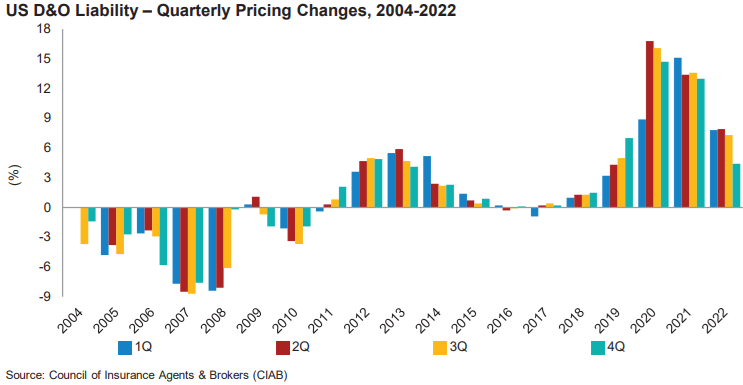Buyers of directors and officers liability may be getting a break from steep rate and price increases seen over the last several years, but insurance industry rating agency AM Best said it remains to be seen how long the reprieve can last.
“Pricing increases in 2022 were barely enough to keep up with economic inflation, and fourth-quarter rate increases were even lower,” AM Best observed in a new market segment report on U.S. D&O.
Following hard market conditions — particularly for public D&O risks — that began toward the end of 2019, the D&O market stabilized in 2022 as prices increased an average of 5 percent by the end of the year, with flat renewal pricing. Increases in prices in the several years prior to 2022 invited new capital to the marketplace, aiding in the leveling of rates.
Though D&O direct premiums written in 2022 remained 77 percent higher than in 2019, current pricing of the emerging and evolving risks faced by corporate directors and officers “could yield premiums that prove inadequate to cover potential claims,” AM Best said.
While there has been a drop in federal securities class-action lawsuits since current economic conditions dampened the initial public offering (IPO) market and special purpose acquisition companies (SPACs), more cases may come forward as courts return to normal following closures due to the pandemic. Additionally, recent bank failures could result in larger claims for the line, and the ongoing trend of social inflation may balloon settlement amounts, AM Best said.
Recent bank failures have “led to intense scrutiny of banks’ executive leadership and boards of directors, although no suits have been filed as of yet,” AM Best added. “Public officials have pointed to unsuccessful or inadequate risk management in identifying and managing interest rate risk and liquidity risk, as well as overexposures to certain industry sectors amid sharply rising interest rates, as reasons these banks failed. Ultimately, what will come into question is whether managers and directors actively and thoughtfully monitored all relevant risks.”
On the horizon, risks associated with artificial intelligence, litigation funding, and environmental, social and governance (ESG) requirements remain potential challenges.
Though AI has its benefits, its use also comes with the risks of exposing confidential information, cybersecurity vulnerabilities and accusations of bias. Meanwhile, the trend of third-party litigation involvement in D&O lawsuits has proven to increase awards and settlements.
Shareholder scrutiny of company ESG disclosures could also lead to D&O lawsuits. “The legal costs and settlements that these lawsuits could result in remain unknown, and underwriters are taking a conservative approach in pricing for these exposures,” AM Best said.





















 The Power of the First Offer: Anchoring, Evidence and the Battle for Perception
The Power of the First Offer: Anchoring, Evidence and the Battle for Perception  Evolving Trends in Coverage Litigation: What Carriers Need to Know
Evolving Trends in Coverage Litigation: What Carriers Need to Know  Artificial Intelligence on Trial: What Recent Lawsuits Reveal About Casualty Exposure
Artificial Intelligence on Trial: What Recent Lawsuits Reveal About Casualty Exposure  What Progressive and GEICO Q3 Results Reveal About Auto Insurance Profit, Growth
What Progressive and GEICO Q3 Results Reveal About Auto Insurance Profit, Growth 